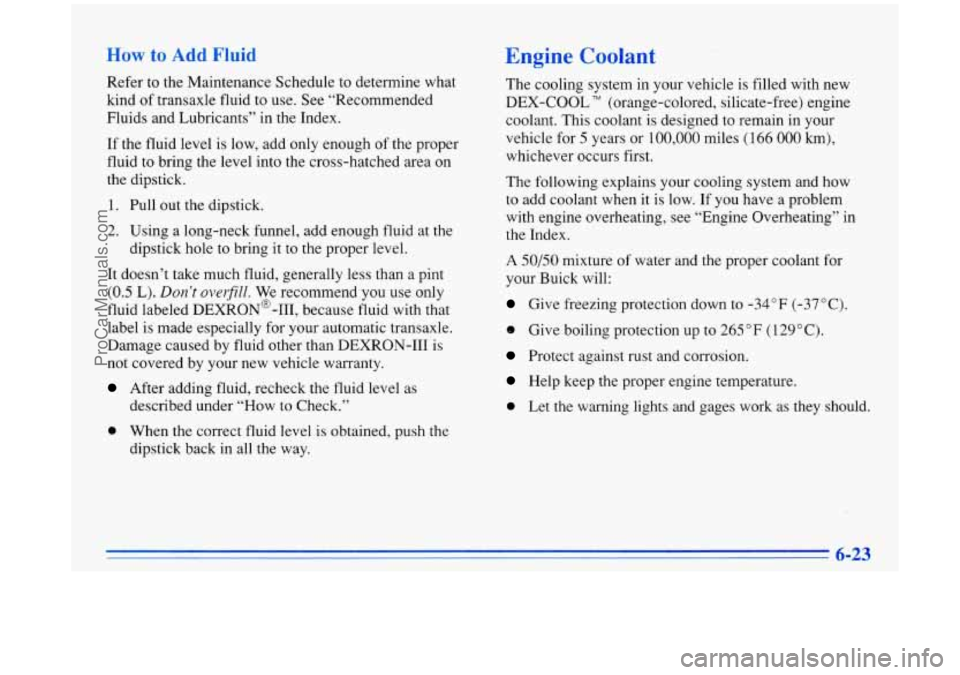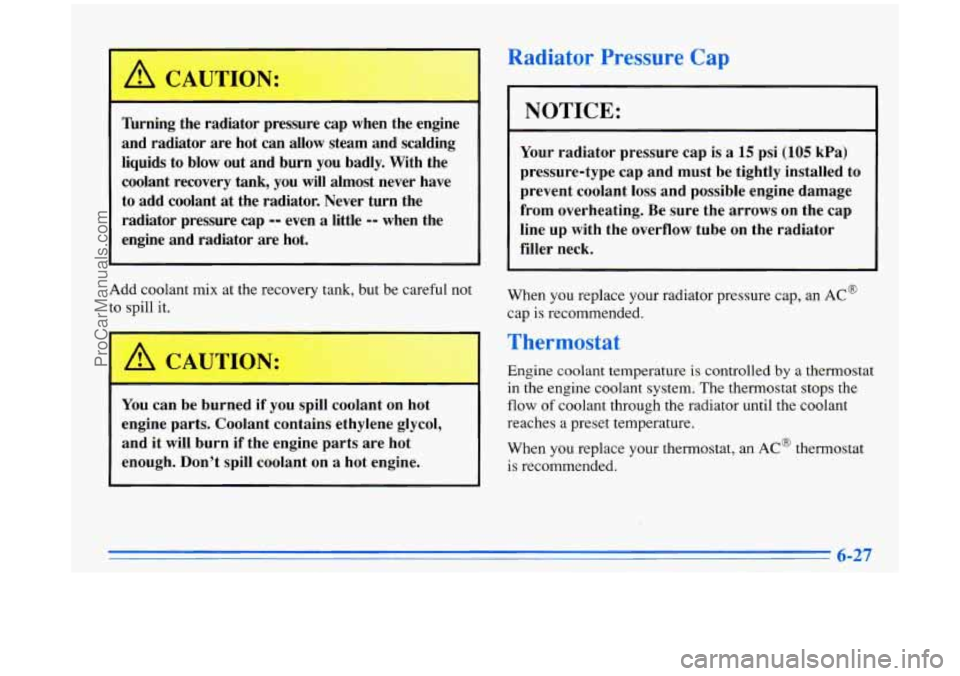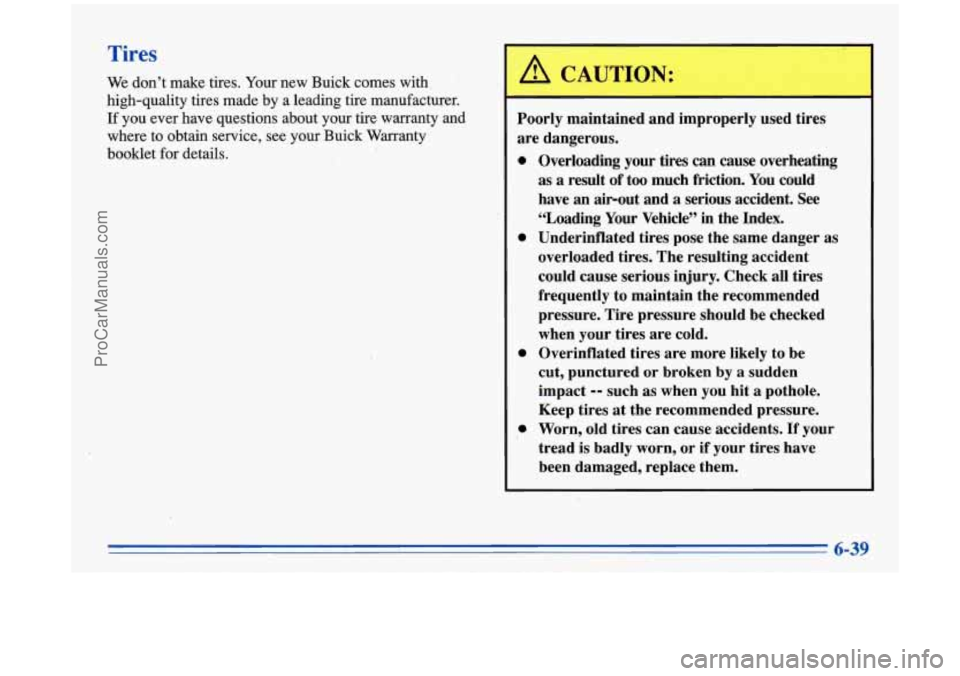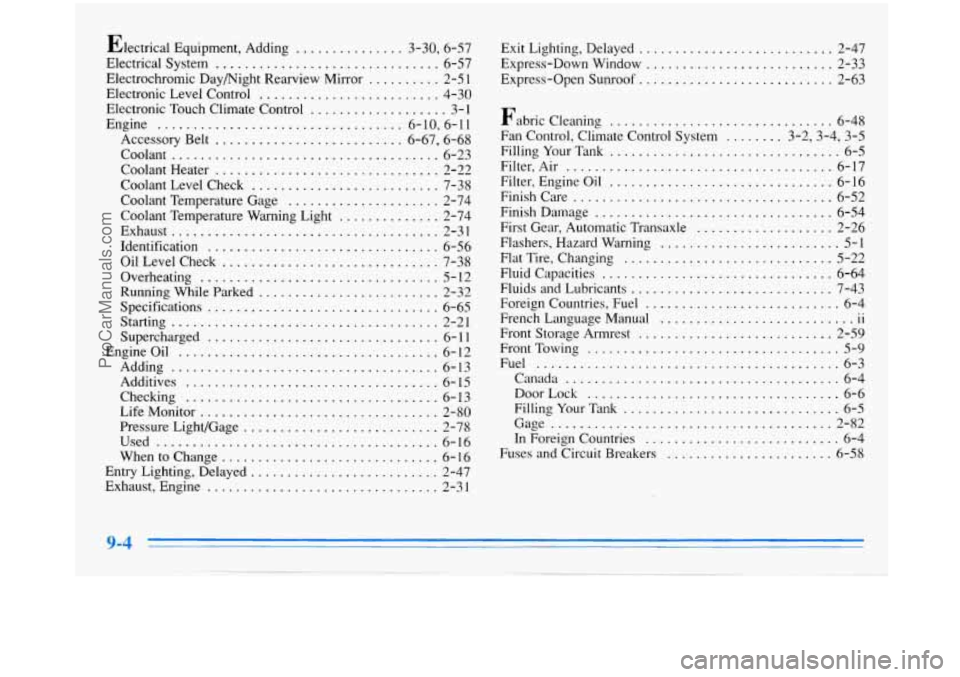1996 BUICK PARK AVENUE overheating
[x] Cancel search: overheatingPage 130 of 388

Engine Coolant Temperature
Warning Light
h -
TEMP
One of these lights will come on to tell you that your
engine coolant has overheated or your radiator cooling
fans are not working.
If you have been operating your
,vehicle under normal driving conditions, you should
pull
off the road, stop your vehicle and turn the engine
off as soon as possible. I
The section “Problems on the Road,” in this
manual explains what to
do. See “Engine Overheating”
in the Index.
Engine Coolant Temperature Gage (Option)
If’ you have the gage cluster,
you have a gage that shows
the engine coolant
temperature
in degrees
Fahrenheit. Canadian
instrument panels measure
the coolant temperature in
degrees Celsius.
-If the gage
pointer moves into the red
area, your engine is too hot!
That reading means ,the same thing as the warning light.
It means that your engine coolant has overheated. If you
have been operating.your vehicle under normal driving
conditions, you should pull
off the road, stop your
vehicle and turn
off the engine as soon as possible.
The section “Problems’ on the Road,” in
this
manual explains what to do. See “Engine Overheating”
in the Index.
2-74
ProCarManuals.com
Page 210 of 388

Tbrn Signals When Towing a Trailer
The arrows on your instrument panel will flash
whenever you signal a turn or lane change. Properly
hooked up, the trailer lamps will also flash, telling other
drivers you’re about
to turn, change lanes or stop.
When towing a trailer, the arrows on your instrument
panel will flash for turns even if the bulbs on the trailer
are burned out. Thus, you may think drivers behind you
are seeing your signal when they are not. It’s important
to check occasionally to be sure the trailer bulbs are still
working.
Your vehicle
has bulb warning lights. When you plug a
trailer lighting system into your vehicle’s lighting
system, its bulb warning lights may not let you know if
one of your lamps goes out.
So, when you have a trailer
lighting system plugged in, be sure
to check your
vehicle and trailer lamps from time to time to be sure
they’re all working. Once you disconnect the trailer
lamps, the bulb warning lights again can tell you if one
of your vehicle lamps
is out.
Driving On Grades
Reduce speed and shift to a lower gear before you start
down a long or steep downgrade.
If you don’t shift
down, you might have to use your brakes
so much that
they would get hot and no longer work well.
On a long uphill grade,
shift down to THIRD (3) and
reduce your speed to around
45 mph (70 km/h) to reduce
the possibility of engine and transaxle overheating.
Parking on Hills
You really should not park your vehicle, with a trailer
attached, on a hill.
If something goes wrong, your rig
could start to move. People can be injured, and both
your vehicle and the trailer can
be damaged.
But if you ever have to park your rig on a hill, here’s
how
to do it:
1. Apply your regular brakes, but don’t shift into
PARK (P) yet.
2. Have someone place chocks under the trailer wheels.
3. When the wheel chocks are in place, release the
regular brakes until the chocks absorb the load.
4. Reapply the regular brakes. Then apply your parking
5. Release the regular brakes.
brake, and the shift
to PARK
(P).
4-36
ProCarManuals.com
Page 224 of 388

Engine Overheating
You will find a warning light about a hot engine on your
Buick instrument panel and
if you have the optional
gage cluster, a coolant temperature gage. You
will also
find a LOW COOLANT warning light.
If Steam Is Coming From Your Engine
Steam from an overheated engine can burn you
badly, even if you just open the hood. Stay away
from the engine
if you see or hear steam coming
from it. Just turn it off and get everyone away
from the vehicle until it cools down. Wait until
there
is no sign of steam or coolant before
opening the hood.
If you keep driving when your engine is
overheated, the liquids in it can catch fire.
You or
others could be
badly burned. Stop your engine if
it overheats, and get out of the vehicle until the
engine is cool.
,
NOTICE:
If your engine catches fire because you keep
driving with no coolant, your vehicle can be
badly damaged. The costly repairs would not be
covered
by your warranty.
5-12
ProCarManuals.com
Page 227 of 388

The coolant level should be at or above the FULL
COLD mark. If it isn't, you may have a leak in the
radiator hoses, heater hoses, radiator, water
purnp or
somewhere elsC
in the-cooling system..
I A CAUTION:
I
Heater and radiator hoses, and other engine
parts, can be very hot. Don't touch them.
If you
do, you can be burned.
Don't run the engine
if there is a leak. If you run
the engine, it could lose all coolant. That could
cause an' engine fire, -and you could be burned.
Get any leak fixed before you drive the vehicle.
I NOTICE:
Engine damage from running your engine
without coolant isn't covered
by your warranty.
If there seems to be no leak, with the engine on, check to
see if the electric engine fans are running.
If the engine
is overheating, both fans should be running.
If they
aren't, your vehicle needs service.
5-15 ,
ProCarManuals.com
Page 271 of 388

How to Add Fluid
Refer to the Maintenance Schedule to determine what
kind of transaxle fluid to use. See “Recommended
Fluids and Lubricants” in the Index.
If the fluid level is low, add only enough
of the proper
fluid to bring the level into the cross-hatched area on
the dipstick.
1. Pull out the dipstick.
2. Using a long-neck funnel, add enough fluid at the
It doesn’t take much fluid, generally less than a pint
(0.5 L). Don’t ovel-fill. We recommend you use only
fluid labeled DEXRON@-111, because fluid with that
label is made especially for your automatic transaxle.
Damage caused by fluid other than DEXRON-I11 is
not covered by your new vehicle warranty.
dipstick hole to
bring it to the proper level.
After adding fluid, recheck the fluid level as
described under “How to Check.”
0 When the correct fluid level is obtained, push the
dipstick back in all the way.
Engine Coolant
The cooling system in your vehicle is filled with new
DEX-COOL
TM (orange-colored, silicate-free) engine
coolant. This coolant is designed to remain in your
vehicle for
5 years or 100,000 miles (166 000 km),
whichever occurs first.
The following explains your cooling system and how
to add coolant when
it is low. If you have a problem
with engine overheating, see “Engine Overheating” in
the Index.
A 50/50 mixture of water and the proper coolant for
your Buick will:
Give freezing protection down to -34°F (-37°C).
9 Give boiling protection up to 265 OF ( 129 O C).
Protect against rust and corrosion.
Help keep the proper engine temperature.
0 Let the warning lights and gages work as they should.
ProCarManuals.com
Page 275 of 388

nrning the radiator pressure cap when the engine
and radiator are hot can allow steam and scalding
liquids to blow out and burn
you badly. With the
coolant recovery tank, you
will almost never have
to add coolant at the radiator. Never turn the
radiator pressure cap
-- even a little -- when the
engine
and radiator are hot.
Add coolant mix at the recovery tank, but be careful not
to spill it.
You can be burned if you spill coolant on hot
engine parts. Coolant contains ethylene glycol,
and it will burn if the engine parts are hot
enough. Don’t spill coolant on
a hot engine.
Radiator Pressure Cap
NOTICE:
Your radiator pressure cap is a 15 psi (105 kPa)
pressure-type cap and must be tightly installed to
prevent coolant loss and possible engine damage
from overheating. Be sure the arrows
on the cap
line up with the overflow tube on the radiator
filler neck.
When you replace your radiator pressure cap, an
AC@
cap is recommended.
Thermostat
Engine coolant temperature is controlled by a thermostat
in the engine coolant system.
The thermostat stops the
flow of coolant through the radiator until the coolant
reaches a preset temperature.
When you replace your thermostat, an
AC@ thermostat
is recommended.
ProCarManuals.com
Page 287 of 388

Tires
We don’t make tires. Your new Buick comes with ’
high-quality tires made by a leading tire manufacturer.
If you ever have qu,estions about your tire warranty and
where to obtain service, see your Buick Warranty
booklet for details.
A C IUTION:
-
Poorly maintained and improperly used tires
are dangerous.
0
0
Overloading your tires can cause overheating
as
a result of too much friction. You could
have
an about and a serious accident. See
“Loading Your Vehicle” in the Index.
Underinflated tires pose the same danger
as
overloaded tires. The resulting accident
could cause serious injury. Check all tires
frequently to maintain the recommended
pressure. Tire pressure should be checked
when your tires are cold.
Overinflated tires are more likely to be
cut, punctured or broken
by a sudden
impact
-- such as when you hit a pothole.
Keep tires at the recommended pressure. Worn, old tires can cause accidents.
If your
tread is badly worn, or if your tires have
been damaged, replace them.
6-39
ProCarManuals.com
Page 378 of 388

Electrical Equipment. Adding ............... 3.30. 6.57
Electrical System
............................... 6-57
Electrochromic Daymight Rearview Mirror
.......... 2-5 1
Electronic Level Control ......................... 4-30
Electronic Touch Climate Control
................... 3- 1
Engine
.................................. 6.10. 6.11
Accessory Belt
.......................... 6.67. 6.68
Coolant
..................................... 6-23
Coolant Heater
............................... 2-22
Coolant Level Check
.......................... 7-38
Coolant Temperature Gage
..................... 2-74
Coolant Temperature Warning Light
.............. 2-74
Exhaust
..................................... 2-31
Identification
................................ 6-56
OilLevelCheck
.............................. 7-38
Overheating
................................. 5-12
Running While Parked
......................... 2-32
Specifications
................................ 6-65
Starting
..................................... 2-21
Engineoil
.................................... 6- 12
Adding
..................................... 6-13
Supercharged
................................ 6-11
Additives
................................... 6-15
Checking
................................... 6-13
LifeMonitor
................................. 2-80
Pressure Light/Gage
........................... 2-78
Used
....................................... 6-16
Whentochange
.............................. 6-16
Entry Lighting. Delayed
.......................... 2-47
Exhaust. Engine
................................ 2-31 Exit Lighting. Delayed
........................... 2-47
Express-Down Window
.......................... 2-33
Express-Open Sunroof
........................... 2-63
Fabric Cleaning
............................... 6-48
Fan Control. Climate Control System
........ 3.2.3.4. 3.5
Filling Your Tank ................................ 6-5
Filter. Air
..................................... 6-17
Filter. Engine Oil
............................... 6-16
Finish Care
.................................... 6-52
Finish Damage
................................. 6-54
First Gear, Automatic Transaxle
................... 2-26
Flashers. Hazard Warning
......................... 5-1
Flat Tire. Changing
............................. 5-22
Fluid Capacities
................................ 6-64
Fluids and Lubricants
............................ 7-43
Foreign Countries, Fuel
........................... 6-4
French Language Manual
11
Front Storage Armrest ........................... 2-59
FrontTowing
................................... 5-9
Fuel .......................................... 6-3
Canada
...................................... 6-4
DoorLock
................................... 6-6
Filling Your Tank
.............................. 6-5
Gage
....................................... 2-82
In Foreign Countries
........................... 6-4
Fuses and Circuit Breakers
....................... 6-58
.. ...........................
9-4
ProCarManuals.com